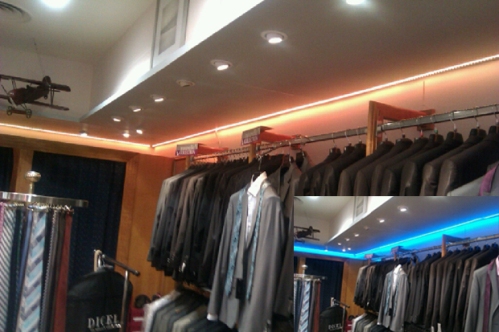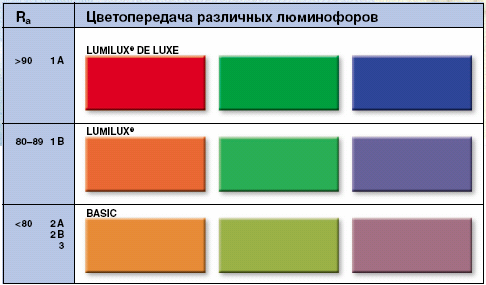Categories: Featured Articles » Sources of light
Number of views: 39769
Comments on the article: 1
What is lamp color rendering index?
 It is known that two lamps of different types, even with the same color temperature, such as a fluorescent lamp and an incandescent lamp, often convey the colors of the objects illuminated by them in different ways. A fluorescent lamp, in comparison with an incandescent lamp, has less energy in the red region of the spectrum, therefore the red color appears brighter when an incandescent lamp illuminates a body than when a fluorescent lamp illuminates the same body with the same color temperature. So, the color rendering properties of various lamps directly depend on the nature of the spectrum of their radiation.
It is known that two lamps of different types, even with the same color temperature, such as a fluorescent lamp and an incandescent lamp, often convey the colors of the objects illuminated by them in different ways. A fluorescent lamp, in comparison with an incandescent lamp, has less energy in the red region of the spectrum, therefore the red color appears brighter when an incandescent lamp illuminates a body than when a fluorescent lamp illuminates the same body with the same color temperature. So, the color rendering properties of various lamps directly depend on the nature of the spectrum of their radiation.
The parameter characterizing the degree of correspondence of the natural color of the object to the visible color of this object when illuminated by this light source is called the color rendering index Ra, or the color rendering coefficient, in English color rendering index, or CRI for short.
This value is relative, and Ra of the reference light source is taken equal to 100. At the same time, the range of color rendering indices from 80 to 100 is comfortable for the human eye, for example a conventional 60 W incandescent lamp has a color rendering index Ra of 80, at a color temperature of 2680K.
In studies, daylight is used as a guideline, with which the light of electric lamps is compared. In 1948, Peter Baum, in his work “Physical Aspects of Color: An Introduction to the Scientific Study of Color Incentives and Color Sensations,” wrote: “Daylight contains a wide variety of colors, making it easy to distinguish between minor shades, and the colors of objects around us obviously look naturally".
In the mid-20th century, scientists began to make attempts to assess the ability of artificial light sources to accurately reproduce natural colors, and around the 1960s or 1970s, the term "color rendering coefficient" began to be applied. CRI was used to compare continuous-spectrum light sources with a color rendering index above 90. Technically, the color rendering index can only be compared with light sources that have the same color temperature.

In order to obtain the color rendering index value for a particular electric lamp, the color shift is determined by illuminating 8 standard reference colors (DIN 6169) with the lamp under study. The calculation is made according to the methodology of the International Commission on Lighting (CIE), which gives a numerical value of the deviation of color from the standards.
The smaller the deviation, the better the color rendering parameters of the tested lamp, and, accordingly, the higher its color rendering index. According to the measurement results, the average deviations are subtracted from 100, and the exact numerical value of the color rendering index is obtained. So, with small deviations Ra will be closer to 100, and with large deviations it will be much less. If there are no deviations, then the source is assigned a value of Ra equal to 100.
To compare the color temperatures of the range from 2000K to 5000K, the "blackbody emitter" is used as a reference source, and daylight is used for higher color temperatures. It is important to remember, however, that neither incandescent lamps nor the sky of the northern hemisphere have perfect color rendition, but their color rendering index is assumed to be 100. Meanwhile, incandescent lamps are weak when lighting shades of blue, and the sky (7500K) when lighting red tones .
In practice, a color rendering index from 90 to 100 is considered to be impeccable, and the scope of such sources includes those areas where a very accurate color assessment is important. Ra from 80 to 90 are considered good indicators, and if in a given situation an accurate color assessment is not important, but high-quality color reproduction is required, such light sources are suitable.
If color reproduction is not important, then light sources with satisfactory and poor performance are acceptable, that is, with Ra less than 80. In general, differences in these values by less than 5 units are hardly noticeable, and distinguishing 80 and 84 is by no means easy.

The average color rendering coefficients of various types of lamps are known. Incandescent light, as well as light halogen lamps, is close to solar, and the Ra value for them is close to 100. The color rendering index of high pressure metal halide discharge lamps also reaches 90 and above. Fluorescent lamps of many manufacturers have rather high Ra values from 80 to 90, but some budget models may have Ra less than 75, in any case, you should pay attention to the characteristics indicated on the package.
LED lamp, as well as luminescent, depending on the quality, they can vary in color rendering index, however, the best examples show a value of Ra 80 and higher. Mercury and sodium discharge lamps differ in the lowest color rendering index; here Ra is less than 40.

Relatively specifically to LEDs, studies were conducted in which both red-green-blue LEDs and phosphorus-coated white LEDs were considered.
An assessment was made, from which it followed that RGB LEDs had color rendering coefficients in the region of 20, but when rendering colors, they showed themselves well, since the visible saturation of specific colors increased without color shift of the shades. In this case, the white light obtained by mixing the light of red, green and blue LEDs is preferable to the light of halogen lamps and incandescent lamps, despite the high color rendering indices of the latter.
According to the research, the International Commission on Lighting concluded: “the color rendering index developed by the commission is usually not applicable for predicting the color rendering parameters of a set of light sources if this set includes white LEDs.”
Thus, the color rendering coefficient Ra can serve as one of the information parameters used for the assessment and LED lighting systems, however, in order to obtain the most acceptable results, preliminary tests and individual product evaluations are required right at the place of the intended operation.
See also at bgv.electricianexp.com
:
